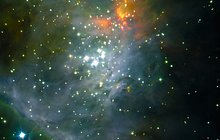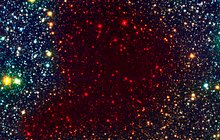SOFI
Son of ISAAC
Cosmic dust is a key component of galaxies, stars and planets. But, as ESO astronomer and SOFI Instrument Scientist Valentin Ivanov says: “Just like on Earth, dust can obscure our vision of astronomical objects. The Universe is full of dust, and we can't just collect it up with a cloth or a vacuum cleaner”.
Huge clouds of dust block the light coming from many objects in Universe, leaving astronomers with no information to analyse. In particular hot young stars, that emit light strongly at the blue end of the spectrum, are difficult to observe, because in general, “the bluer the light, the harder it is for us to see it because of intervening dust,” says Ivanov. To make things worse, these stars are often shrouded by clouds of dust.
 To overcome this difficulty, astronomers resort to looking in redder light, the infrared, to peek through the dust. Instruments like SOFI, which stands for the Son of ISAAC ( ISAAC was a similar instrument at ESO’s Very Large Telescope (VLT)) see infrared light very successfully.
To overcome this difficulty, astronomers resort to looking in redder light, the infrared, to peek through the dust. Instruments like SOFI, which stands for the Son of ISAAC ( ISAAC was a similar instrument at ESO’s Very Large Telescope (VLT)) see infrared light very successfully.
SOFI is installed at La Silla Observatory on the New Technology Telescope and was built to detect near-infrared light, with a wavelength between 0.8 and 2.5 micrometres. This kind of light propagates much better through dust, allowing astronomers to study the objects hidden behind the clouds. “Infrared light is invisible to the human eye, although we can sense it as heat from, for example, infrared heat lamps. However SOFI can detect levels of infrared light are way below the sensitivity of our skin to heat,” said Valentin.
SOFI has been in the business of making astronomical discoveries since 1998, and has made many contributions with images or through spectroscopy, especially in the study of brown dwarfs.
The first notable SOFI result was the discovery of a methane brown dwarf (eso9942) in 1999. Back then it was one of the few known objects with surface temperature of ~400 ºC, a relatively cold temperature in the Universe. Results obtained in 2003 confirmed that Epsilon Indi B was a brown dwarf, and the nearest of its class at that time (eso0303). In 2006, SOFI was used to discover the first brown dwarf companion to an exoplanet host star (eso0639).
Most recently, the Public ESO Spectroscopic Survey of Transient Objects (PESSTO) obtained near-infrared spectra of hundreds of transient objects with SOFI. These objects were mostly supernovae in nearby galaxies. “As of the end of 2014, more than 600 publications in astronomical journals are based, at least partially, on SOFI data,” says Ivanov.
What makes SOFI so special? The key is the detector at the end of the optical path: it is a Hawaii HgCdTe 1024x1024 pixel array by Teledyne (formerly Rockwell Scientific) which is sensitive to the near-infrared (0.8 and 2.5 micrometres). It has nearly 300 times more pixels and a factor of 100 less electronic noise than the detectors used in the first infrared astronomical cameras 20 years ago, making it significantly more sensitive. The detector is enclosed in a cooled vacuum tank at -200 ºC to reduce the thermal background or noise, that would otherwise quickly saturate the detector and drown out the faint signals it is looking to pick up. This background signal can come from different sources, such as the heat of the human body or machines or components of the telescope itself.
Newer and more versatile near-infrared cameras and spectroscopes have become available in the intervening years since SofI became operational, “but this robust and reliable instrument is still widely used by the astronomical community,” says Valentin Ivanov.
Science highlights with SOFI
- New results pin down the distance to the Large Magellanic Cloud (eso1311)
- Discovery of a body that is very probably a planet wandering through space without a parent star (eso1245)
- SOFI observations help discover a new candidate for the coldest known star: a brown dwarf in a double system with about the same temperature as a freshly made cup of tea (eso1110)
- SOFI maps the interior of interstellar clouds in great detail (eso0806)
- New globular cluster found in Milky Way (eso0712)
- First Directly Imaged Brown Dwarf Companion to an Exoplanet Host Star (eso0639)
- Discovery of Nearest Known Brown Dwarf (eso0303)
- Faintest Methane Brown Dwarf Discovered with the NTT and VLT (eso9942)
|
A raw image obtained with SOFI. The images taken with astronomical instruments always record the intensity levels: the colour information is obtained by taking exposures through different glass filters, in this case the near-infrared K filter. This image was used, together with many others, to produce the infrared component of the B68 image displayed above. |
SOFIThe authoritative technical specifications as offered for astronomical observations are available from the Science Operation page.
|


